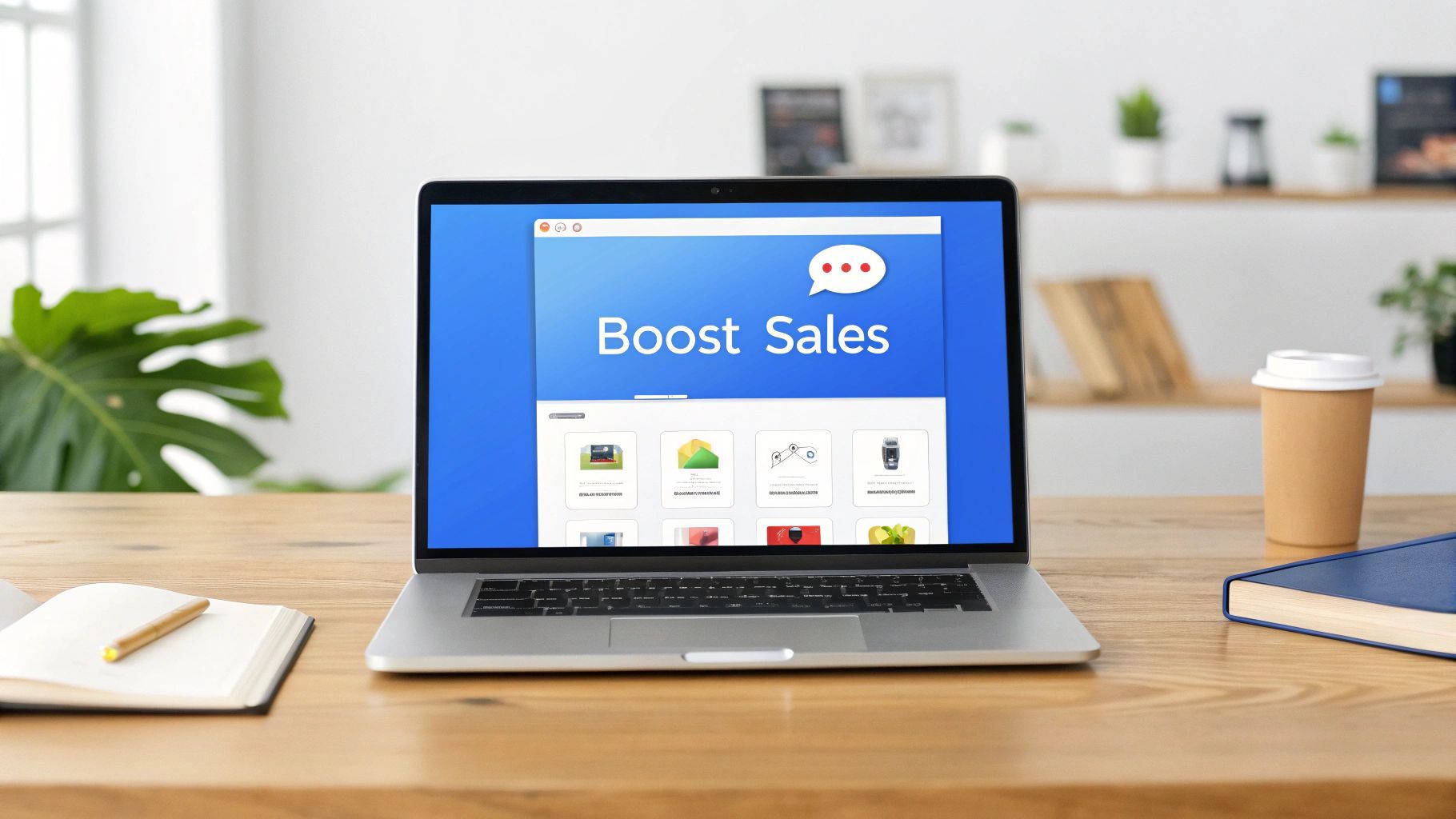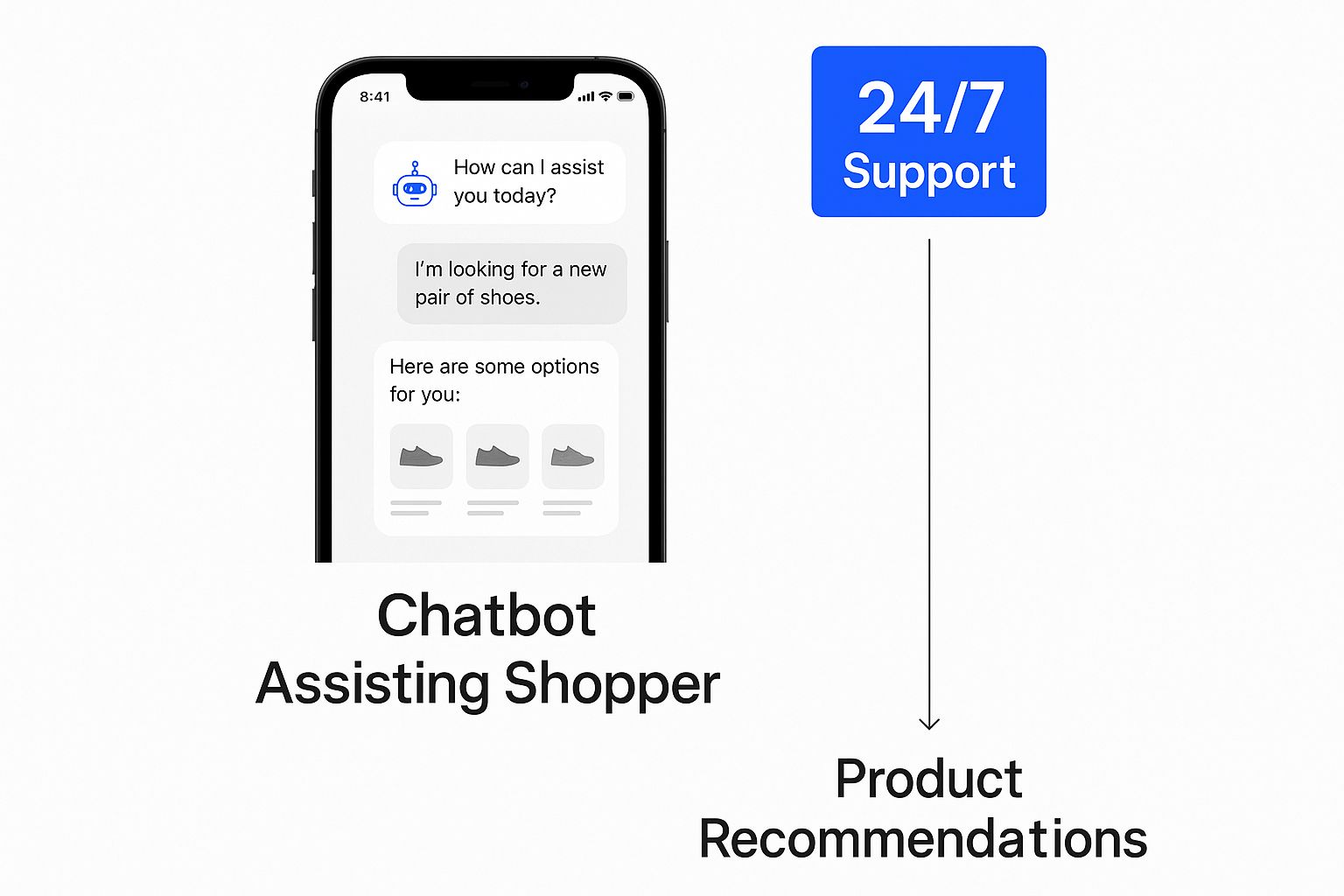
Boost Sales with Chatbots for Ecommerce
Discuss with AI
Get instant insights and ask questions about this topic with AI assistants.
💡 Pro tip: All options include context about this blog post. Feel free to modify the prompt to ask more specific questions!
Think of an ecommerce chatbot as your store's best employee—one that never sleeps. It's a smart software assistant that talks with shoppers, helping them find products, check on their orders, or get answers to questions, any time of day. In short, they're your 24/7 virtual sales associates, making sure every customer feels guided and supported.

Imagine walking into a massive retail store with no one around to help. You'd probably wander around, get frustrated trying to find the right size, and maybe even leave empty-handed. For a long time, this was the standard online shopping experience—customers were left alone to sift through endless product pages.
Now, picture a different scenario. A friendly, sharp expert greets you the moment you walk in. They listen to what you need, point you in the right direction, and have an answer for every question. That's exactly what a good ecommerce chatbot does for your online store.
This move from static websites to interactive chats is what we call conversational commerce. It’s a huge shift in how people connect with brands online. Instead of just one-way browsing, it's all about creating a real, two-way dialogue. Two major things are driving this change:
- Evolving Customer Expectations: Shoppers today want answers, and they want them now. A recent study revealed that 81% of customers would rather find a solution on their own before reaching out to a person. Chatbots give them that instant, self-service help they crave.
- Advancements in AI: The first chatbots were clunky and could only follow a strict script. But thanks to major leaps in artificial intelligence (AI) and Natural Language Processing (NLP), today's bots can understand what you're really asking, learn from past conversations, and offer genuinely personal help.
This isn't some far-off idea anymore; it's quickly becoming the industry standard. The global chatbot market hit $5.4 billion in 2023 and is expected to explode to $15.5 billion by 2028, with ecommerce adoption leading the charge. You can explore more about these market trends to see just how big this is becoming.
What started as a cool gimmick has turned into a must-have for any serious ecommerce business. Chatbots have moved way beyond answering simple FAQs. They are now proactive partners that enhance the entire customer journey, from the first click to a post-purchase thank you.
A chatbot serves as an always-on bridge between a customer's question and a quick, satisfying resolution. This immediate support system is crucial for building trust and preventing the frustration that leads to abandoned carts and lost sales.
By offering instant, tailored help, these tools do more than just fix problems—they create genuinely better shopping experiences. They make an online store feel more human and attentive, which is how you turn casual visitors into loyal customers. Next, we'll dive into the specific features that give these bots their power and show how they deliver real results.
Ever dealt with a chatbot that felt more like a brick wall than a helpful assistant? We’ve all been there. The difference between a genuinely useful bot and a frustrating one comes down to its internal toolkit. A top-notch ecommerce chatbot isn't just one piece of software; it's a sophisticated mix of features working in harmony to make the customer's journey smooth, smart, and satisfying.
Knowing what these features are is like understanding the essential parts of a car before you buy one. You need more than just an engine and wheels; you need the right components working together to get you where you need to go without a breakdown.
The image below gives you a great snapshot of how a modern chatbot offers that always-on, personalized help right on a customer's phone or computer.

As you can see, the core idea is seamless 24/7 support baked right into the shopping experience. This is the bedrock of any chatbot worth its salt in the ecommerce world.
At the very core of any intelligent chatbot, you'll find Natural Language Processing (NLP). Think of NLP as the bot's ability to actually listen and understand, just like a person.
Older, rule-based bots were pretty rigid. They could only spot specific keywords. So, if a customer typed "track order," it was fine. But if they asked, "yo where’s my stuff?" the bot would short-circuit. NLP is the game-changer here. It allows a modern chatbot to decipher intent, get the gist of slang, and even figure out typos. This is what allows for a genuine back-and-forth conversation instead of a clunky, robotic exchange. It's the tech that makes a customer feel like they're actually being heard.
To truly grasp what a powerful chatbot can do for your store, it helps to break down its capabilities. The table below outlines the core features, from the must-have basics to the more advanced functions that drive sales and engagement. These are the building blocks of a bot that delivers real results.
Feature Category Specific Functionality Primary Business Impact Foundational 24/7 Automated Support Provides instant answers outside of business hours, improving customer satisfaction and reducing support tickets. Foundational FAQ Automation Instantly resolves common queries about policies, products, etc., freeing up human agents for complex issues. Foundational Order & Shipping Status Gives customers real-time tracking information on demand, significantly lowering "Where is my order?" (WISMO) inquiries. Advanced Proactive Cart Recovery Engages users with abandoned carts by offering help or discounts, directly recovering potentially lost sales. Advanced AI-Driven Product Recommendations Acts as a personal shopper by suggesting relevant products based on user behavior, increasing average order value.
Ultimately, a well-equipped chatbot doesn't just answer questions—it creates better shopping experiences and actively contributes to your bottom line.
Before a chatbot can start closing sales, it has to nail the fundamentals of customer service. These are the non-negotiable features that handle the daily grind of routine questions, which in turn frees up your human team to tackle the trickier problems.
- 24/7 Automated Support: This is the most obvious win. Your chatbot never sleeps. It’s always there to field questions about your shipping policy, return process, or product stock, even at 3 AM on a Sunday.
- Order and Shipping Status: Let's be honest, "Where is my order?" is probably your most common question. A good bot plugs directly into your shipping and logistics software to provide instant, real-time tracking updates.
- FAQ Automation: Think of your entire knowledge base, but instantly accessible. The bot can be trained on all your frequently asked questions, so customers get answers immediately instead of digging through your site or waiting for an email reply.
A great chatbot handles the repetitive, everyday questions with speed and accuracy. This not only improves customer satisfaction but also gives your support agents the bandwidth to focus on high-value interactions that require a human touch.
With a solid support foundation in place, you can add features that transform your chatbot from a simple helper into a proactive sales machine. These are the tools that directly drive revenue and build stronger customer relationships.
This is where the bot starts to feel like an expert personal shopper. By analyzing a customer's browsing history, past purchases, and the very questions they're asking, an intelligent chatbot can recommend products they'll genuinely want.
For instance, if someone asks for "warm jackets for hiking," the bot can do more than just show a list. It can ask clarifying questions about their preferred color, the weather they'll be in, or their price range to zero in on the perfect options. Suddenly, the bot isn't just a tool; it's a trusted advisor.
We all know cart abandonment is a huge headache for online stores—in fact, nearly 70% of online shopping carts are left behind. An advanced chatbot can spot a user who seems to be hesitating or has left items sitting in their cart. It can then proactively pop up to offer a small discount, answer a last-minute question about shipping, or give a gentle reminder to complete the purchase. That little nudge is often all it takes to recover a sale you would have otherwise lost.
It's easy to get caught up in the cool features of chatbots, but their real magic is what they do for your bottom line. Think of a chatbot less like a fancy tech tool and more like a tireless team member, working 24/7 to solve some of the biggest headaches online stores face. It’s not just about deflecting support tickets; it’s about turning potential problems into real, measurable growth.
One of the first things you'll notice is a big drop in your operational costs. Let's be honest, your support team probably spends a massive chunk of its day answering the same questions over and over: "Where's my order?", "What's your return policy?", "Is this in stock?". A chatbot can handle thousands of these conversations instantly, freeing up your human experts to focus on the tricky, high-stakes issues where their skills truly shine.
This isn't just a small efficiency gain—it's a game-changer. By 2025, it's predicted that chatbots will save businesses a staggering $11 billion and nearly 2.5 billion work hours every single year. These numbers point to a fundamental shift in customer service, placing chatbots at the heart of any smart ecommerce operation.
A great chatbot isn't just a problem-solver; it's a savvy salesperson. It doesn't just sit back and wait for questions—it actively looks for opportunities to help customers find (and buy) more. By paying attention to what a shopper is looking at or asking about, the bot can serve up incredibly relevant product recommendations, almost like a personal shopper.
For instance, if someone is asking about a specific pair of running shoes, the bot can naturally follow up by suggesting a great pair of moisture-wicking socks to go with them. This kind of intelligent upselling and cross-selling can seriously boost your Average Order Value (AOV), and it feels helpful, not pushy.
But that's not all. These bots are masters at rescuing sales that might have otherwise slipped away. They can:
- Nudge hesitant shoppers: If someone has been lingering on a product page for a while, the bot can pop up with a "Hey, got any questions about this?" to keep them engaged.
- Recover abandoned carts: The bot can send a friendly reminder to a customer who left items in their cart, maybe even offering a small discount to sweeten the deal.
- Clear the path to checkout: By answering last-minute questions about shipping costs or payment options, the bot removes that final bit of friction that often stops a sale.
In today's world, instant gratification isn't a bonus; it's the baseline expectation. When a customer has a question at 10 PM on a Saturday, they don't want to wait until Monday morning for an email reply. Chatbots deliver that immediate, 24/7 support that people now demand, and that alone is a massive win for customer satisfaction.
It's the small frustrations—like waiting hours for a simple answer—that slowly poison a customer's perception of your brand. A quick, painless resolution does the opposite; it builds confidence and makes them want to come back.
This kind of reliable, always-on help builds a foundation of trust and loyalty. When customers know they can count on you for a fast answer anytime, they feel much more secure buying from you. It's a powerful way of reducing customer churn and turning first-time buyers into loyal fans. You can see more examples of this in action in our guide on the top use cases for chatbots. Ultimately, that reliability is what grows your business for the long haul.
Bringing a chatbot into your ecommerce world isn't something you do on a whim. It’s a thoughtful process, much like building a house—you need a solid blueprint before you even think about laying the first brick. Getting it right starts with a clear vision and unfolds through careful stages of planning, selecting, and launching.
The most important first step? Figure out its primary job. It's tempting to want a bot that does everything at once, but that’s a recipe for a mediocre experience. Instead, focus on the single most valuable task you need it to accomplish.
Getting this part right will make every other decision down the line infinitely easier. What specific problem are you trying to solve, or what business outcome are you chasing? Your core objective will likely be one of these:
- Slash Support Costs: Maybe your main goal is to automate the top 5-10 most common customer questions. This simple focus can take a huge load off your human team, freeing them from repetitive work.
- Boost Conversion Rates: Perhaps it's all about sales. In this case, your chatbot's mission is to proactively greet visitors, recommend the perfect products, and gently nudge them toward the checkout.
- Generate Higher-Quality Leads: For some stores, the bot is a friendly front-line qualifier. Its job is to chat with visitors, identify those with serious buying intent, and collect their details for your sales team to follow up.
Once you’ve locked in that one core mission, you’re ready for the next big decision.
This is the classic "build vs. buy" crossroads every business faces with new tech. Each path has its own set of pros and cons, and the right choice depends entirely on your resources and needs.
Buying a Platform (The Recommended Route) Honestly, for most ecommerce businesses, buying a ready-made chatbot platform is the smartest move. These tools are built specifically for commerce, packed with the integrations, templates, and analytics you need right out of the box.
Think of it like this: opting for a platform is like moving into a professionally designed, pre-built home. The foundation is solid, the plumbing and electricity are already hooked up, and you can get straight to decorating. You don't need an architecture degree to live in it.
Building a Custom Solution Building a bot from the ground up gives you complete control, but it's a massive undertaking. It demands a serious investment of time, money, and highly specialized talent (like AI developers and conversation designers). This route really only makes sense for large enterprises with truly unique needs that no off-the-shelf platform can handle.
So, you've wisely decided to buy a platform. Now comes the fun part: picking the right one. Not all chatbots for ecommerce are made equal, so you need to do your homework. Here’s what to look for:
- Seamless Integrations: The chatbot absolutely must play nice with your current tools. Does it have plug-and-play integrations for Shopify, WooCommerce, your CRM, and your inventory system? If not, you're signing up for a headache.
- Scalability: You're planning to grow, right? Your chatbot platform should be ready to grow with you. Make sure it can handle a spike in traffic and conversations without breaking a sweat.
- Ease of Use: You shouldn't need a developer on speed dial to make a simple change. Look for a platform with a user-friendly, no-code visual builder. Your marketing team should feel empowered to create and tweak conversation flows themselves.
- Budget Alignment: Prices can be all over the map. Find a vendor with a transparent pricing model—whether it's based on conversation volume, features, or agent seats—that fits comfortably within your budget.
This whole process is about more than just adding a widget to your site; it’s a strategic move. To see how chatbots fit into the larger growth engine, you can learn more about ecommerce marketing automation and how these systems work in concert.
With your goal set and platform chosen, it's time to bring your bot to life. A smooth rollout follows a few key steps:
- Design the Conversation Flow: Start by mapping out the ideal chat. If your goal is handling "Where is my order?" questions, design a simple path that asks for an order number and provides the status. Keep it focused.
- Develop Your Bot's Persona: Your bot is an extension of your brand. Give it a name and a personality. Is it helpful and professional? Witty and fun? Whatever you choose, make it consistent.
- Train Your Chatbot: This is crucial. Feed your bot all your FAQ content, product details, and return policies. The more knowledge you give it, the smarter and more helpful it will be.
- Plan a Soft Launch: Don't just flip the switch for everyone at once. Test the chatbot on a few specific pages or with a small segment of your audience first to work out any kinks.
- Monitor and Iterate: Once it's live, your job isn't done. Constantly check the conversation logs. See where people get stuck or what questions the bot fumbles. Use those insights to continuously refine its responses and make it better over time.

Getting your ecommerce chatbot live is a huge step, but it's really just the beginning. The difference between a bot that customers find genuinely helpful and one they immediately close comes down to ongoing strategy and a bit of finesse. A truly great bot is designed with the user's needs—and potential frustrations—in mind, turning a simple tool into a memorable extension of your brand.
Think of it like tuning a high-performance engine. You've built the machine, but now you need to dial it in for a smooth, enjoyable ride. This is about more than just programming the right answers; it’s about crafting a personality, providing a safety net for customers, and committing to constant improvement. Your goal is to make every interaction feel helpful, not robotic, and to ensure no one ever feels stuck in a conversation loop.
One of the fastest ways to make a chatbot feel less like a cold piece of software is to give it some personality. This doesn't mean it needs to start cracking jokes or dropping trendy slang. It's about defining a consistent voice that feels right at home with your brand.
Is your brand more on the sophisticated, premium side? Your bot's language should probably be professional, polite, and to the point. Are you a fun, direct-to-consumer brand with a younger audience? Then a more casual, enthusiastic tone might be a perfect fit.
Your chatbot is often the first "employee" a new customer interacts with. Its personality should be a direct reflection of your brand's values, creating a consistent and trustworthy experience from the very first "hello."
Even giving your bot a name and a custom avatar can make a huge difference. These small touches help it feel more like a dedicated assistant and less like a generic website widget, making the whole experience much more engaging.
Here’s the golden rule of chatbot design: never let a customer get stuck. No matter how smart your bot is, there will always be situations it can't handle—complex issues, sensitive topics, or just plain unusual questions. A frustrating loop where the bot just keeps repeating, "I don't understand," is an absolute brand-killer.
This is where the human handoff comes in. You have to build a clear and easy escape hatch.
- Offer It Proactively: If the bot fails to understand a question twice in a row, it should automatically offer to connect the user to a live person.
- Make It Obvious: Always include a persistent button or menu option like "Talk to a human" so users can opt out at any point.
- Transfer Context Seamlessly: There's nothing worse than being passed to an agent only to have to repeat everything you just told the bot. Make sure the entire chat history gets passed to the agent so they can pick up right where the bot left off.
A seamless transition shows customers you respect their time and are serious about solving their problem, one way or another.
It’s tempting to try and make your chatbot seem as human as possible, but being transparent is far more valuable. People are generally happy to talk to a bot as long as their expectations are set correctly. In fact, research shows that 40% of users don't care if they're talking to a bot or a human, as long as they get the help they need.
Kick off the conversation with a simple, friendly disclosure. Something like, "Hi! I'm Sparky, your virtual assistant. I can help with X, Y, and Z," works wonders. It builds trust and immediately helps the user understand what the bot can (and can't) do.
A chatbot isn't a "set it and forget it" project. Think of it as a living, breathing part of your customer experience that needs regular attention. You need to be digging into your conversation logs and analytics to spot opportunities for improvement. Look for patterns in questions the bot couldn't answer, find the points where users are dropping off, and see which features they engage with the most.
This data is a goldmine for improving not just your bot, but your entire business. The insights you can pull from these conversations are incredibly valuable, especially as the technology continues to expand. Market forecasts show the explosive growth of chatbots for ecommerce, with the global AI chatbot market valued at around $15.6 billion in 2024 and projected to hit $46.6 billion by 2029. You can read the full report on chatbot market statistics to get a sense of the scale here.
By following these practical guidelines, you can turn your bot from a simple Q&A tool into a core part of your customer journey. For an even deeper dive, check out our guide on chatbot best practices for more advanced strategies.
Jumping into any new technology brings up questions. It's only natural to be a little skeptical, especially when it comes to something as important as customer communication. When we talk to store owners about chatbots for ecommerce, the same handful of great questions always pop up—usually around cost, complexity, and how they really perform in the wild.
Let's cut through the jargon and get straight to the answers. This section tackles the most common questions we hear, giving you the clear, practical information you need to decide if a chatbot is right for your business.
This is usually the first thing people ask, and for good reason! The honest answer is: it depends. The price tag can swing wildly based on whether you build a bot from scratch or use an existing platform.
- Building a Custom Bot: This is the high-end, big-budget option. You’re looking at $15,000 to $50,000+ just for the initial build, plus ongoing maintenance. It means hiring developers, conversation designers, and project managers. This route really only makes sense for massive enterprise companies with incredibly unique needs that no off-the-shelf tool can handle.
- Using a Chatbot Platform: For nearly every ecommerce store, this is the way to go. It’s far more affordable and practical. You’ll typically pay a monthly subscription, which can be anywhere from $50 to over $500 per month. The price depends on things like how many conversations you have, the features you need, and how many team members will use it.
Most platforms use a tiered pricing model, so you can start small and upgrade as your store grows. This makes powerful AI accessible even if you're just starting out.
This is a huge concern, and it comes from a real place—we’ve all dealt with those clunky, frustrating bots from a decade ago. But modern AI has come a long way. Today’s best chatbots use something called Natural Language Processing (NLP) to understand what people are actually saying, slang, typos and all. This makes the conversation feel much more natural.
The secret to avoiding that robotic feel comes down to two things:
- Giving it a Personality: You’re in the driver's seat. You get to decide the bot's tone of voice. Want it to be professional and direct? Great. Prefer something a bit more witty and casual? You can do that, too. Giving your bot a name and a friendly avatar helps customers see it as a helpful character, not a cold system.
- Being Upfront: Don't try to fool anyone. It's best to let users know right away that they're talking to a bot. In fact, research shows that 40% of people are perfectly fine with it, as long as it solves their problem. When you set clear expectations, you prevent frustration.
A great chatbot isn't trying to pass as human. It's designed to be an incredibly efficient, friendly, and on-brand assistant that gets the job done right, every time.
The thought of implementing "AI" can sound pretty intimidating, but you don't need a computer science degree to get a chatbot up and running. Modern platforms are built specifically for business owners, not developers.
Most top-tier platforms have a no-code, drag-and-drop visual builder. If you can make a flowchart, you can build a chatbot. You visually map out the conversation, type in the bot's answers, and decide what happens when a customer clicks a button or asks a certain question.
Even better, many platforms offer pre-built templates for common tasks like answering FAQs or tracking orders. You can launch a fully functional bot in just a few hours by customizing a template with your store's info. The final step is usually as simple as adding a small bit of code to your site—just like installing Google Analytics.
Yes, and this is probably the most important feature of a good chatbot. A bot that works in isolation isn't very useful. A bot that connects to your other business tools? That’s where the magic happens.
Look for a platform that offers easy, out-of-the-box integrations with your core systems:
- Ecommerce Platforms: A direct link to Shopify, WooCommerce, or BigCommerce lets the bot instantly check order status, pull up product details, and even help with returns.
- CRM Systems: Connecting to your CRM allows the bot to have more personalized chats and automatically save new lead information.
- Payment Gateways: Integrations with services like Stripe or RazorPay can help streamline the checkout process right inside the chat.
- Messaging Apps: A great bot meets customers on their turf, whether that's on your site, Facebook Messenger, Instagram, or WhatsApp.
Without these connections, your chatbot is just a fancy FAQ page. With them, it becomes the central hub for automating your customer experience.
This is a common fear, but it's based on a misunderstanding of what chatbots are for. The goal isn't to replace your team; it's to make them better at their jobs.
Think about it. A chatbot is brilliant at handling the simple, repetitive questions that tie up your support agents all day. "Where is my order?" "What's your return policy?" "Do you ship to Canada?" A bot can answer thousands of these questions instantly, 24/7, without breaking a sweat.
This frees up your human agents to focus on the work that truly matters:
- Solving complex, high-value customer problems.
- Navigating sensitive situations that require real empathy.
- Providing consultative, expert sales advice.
- Building strong relationships with your best customers.
By automating the routine, you elevate your support team's role. They shift from putting out fires to proactively creating amazing customer experiences. The bot becomes the first line of defense, making sure only the most important conversations ever reach a human.
Ready to see how an AI-powered assistant can transform your customer interactions and drive growth? Spur offers a no-code platform that integrates seamlessly with your favorite ecommerce tools, allowing you to launch a powerful chatbot in minutes. Engage customers 24/7, automate support, and recover sales effortlessly. Start your free 7-day trial of Spur today and experience the future of conversational commerce.
